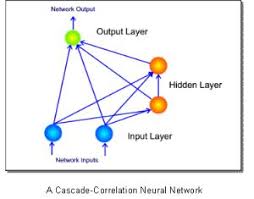Neural networks have revolutionized the field of artificial intelligence, enabling machines to learn complex patterns and make decisions with remarkable accuracy. One particular type of neural network that has gained attention in recent years is the cascade neural network.
A cascade neural network is a type of deep learning architecture that consists of multiple layers of interconnected nodes, or artificial neurons. What sets cascade neural networks apart from traditional feedforward or recurrent neural networks is their unique structure and training methodology.
In a cascade neural network, information flows through a series of stages, with each stage consisting of a smaller neural network called a “cascade classifier.” These cascade classifiers are trained sequentially, starting with a simple classifier at the first stage and progressively increasing in complexity as the information moves through subsequent stages.
This hierarchical approach allows cascade neural networks to efficiently process large amounts of data and quickly identify relevant features at each stage. By breaking down the learning process into smaller, more manageable steps, cascade neural networks can achieve high levels of accuracy while minimizing computational resources.
One notable application of cascade neural networks is in computer vision tasks, such as object detection and facial recognition. By leveraging the hierarchical structure of cascade neural networks, researchers have been able to develop highly efficient algorithms that can accurately detect objects in images and videos in real-time.
Overall, cascade neural networks represent an exciting advancement in the field of deep learning, offering new possibilities for building intelligent systems that can learn and adapt to complex tasks with speed and precision.
Advantages of Cascade Neural Networks: Efficient, Accurate, and Resource-Saving Solutions for Real-Time Applications
- Efficient processing of large amounts of data
- Ability to identify relevant features at each stage
- High accuracy in classification tasks
- Minimization of computational resources
- Effective for real-time applications, such as object detection
- Hierarchical structure enables quick decision-making
7 Challenges of Using Cascade Neural Networks: Complexity, Training Time, and More
- Complex to design and implement due to the hierarchical structure.
- Training multiple cascade classifiers can be time-consuming and computationally intensive.
- May require a large amount of labeled data for training each stage of the network.
- Difficult to interpret and debug compared to simpler neural network architectures.
- Performance highly dependent on the quality of feature extraction at each stage.
- Risk of overfitting if not properly regularized during training.
- Limited flexibility in adapting to new or changing data distributions.
Efficient processing of large amounts of data
Cascade neural networks excel in efficiently processing large amounts of data by employing a hierarchical structure that breaks down the learning process into sequential stages. This approach allows cascade neural networks to identify relevant features and patterns in the data at each stage, leading to more accurate and optimized results. By progressively increasing in complexity as information flows through the network, cascade neural networks can effectively handle vast datasets while minimizing computational resources, making them a powerful tool for tasks that require processing extensive amounts of information with speed and efficiency.
Ability to identify relevant features at each stage
Cascade neural networks offer a significant advantage in their ability to identify relevant features at each stage of the learning process. By breaking down the information into sequential stages with increasingly complex cascade classifiers, these networks can efficiently extract important features from the data. This hierarchical approach not only enhances the network’s accuracy in recognizing patterns but also helps in reducing computational resources needed for processing large datasets. The capability to pinpoint and focus on relevant features at each stage makes cascade neural networks a powerful tool for tasks requiring precise and efficient feature extraction, such as object detection and image recognition.
High accuracy in classification tasks
Cascade neural networks excel in classification tasks by achieving high accuracy levels. The hierarchical structure of cascade neural networks allows for a sequential learning process where information is processed through multiple stages of increasingly complex classifiers. This approach enables the network to identify and extract relevant features efficiently, leading to more accurate classification results. By breaking down the classification task into smaller, specialized steps, cascade neural networks can effectively handle intricate patterns and variations in data, ultimately improving the overall accuracy of the model.
Minimization of computational resources
Cascade neural networks offer the significant advantage of minimizing computational resources. By breaking down the learning process into sequential stages with increasingly complex classifiers, cascade neural networks can efficiently process large amounts of data while achieving high levels of accuracy. This hierarchical approach allows for the identification of relevant features at each stage, reducing the overall computational burden compared to traditional neural network architectures. As a result, cascade neural networks are well-suited for tasks that require real-time processing and resource efficiency, making them a valuable tool in various fields such as computer vision and pattern recognition.
Effective for real-time applications, such as object detection
Cascade neural networks offer a significant advantage in real-time applications, particularly in tasks like object detection. The hierarchical structure of cascade neural networks allows for efficient processing of data, enabling quick and accurate identification of objects in images or videos. By breaking down the learning process into sequential stages of increasing complexity, cascade neural networks can rapidly analyze visual information and make timely decisions, making them well-suited for applications that require fast and precise object detection in real-time scenarios.
Hierarchical structure enables quick decision-making
The hierarchical structure of cascade neural networks plays a crucial role in enabling quick decision-making. By breaking down the learning process into multiple stages, each with its own cascade classifier, the network can efficiently analyze and process information in a sequential manner. This allows cascade neural networks to identify relevant features at each stage, leading to faster and more accurate decision-making compared to traditional neural network architectures. The hierarchical organization facilitates a streamlined flow of information through the network, enabling rapid responses to complex tasks and making cascade neural networks well-suited for applications requiring real-time decision-making capabilities.
Complex to design and implement due to the hierarchical structure.
Designing and implementing cascade neural networks can be challenging due to their hierarchical structure. The need to create and train multiple cascade classifiers at different stages adds complexity to the development process. Ensuring that each stage effectively captures and processes relevant features while maintaining overall network performance requires careful consideration and expertise. Additionally, optimizing the interactions between stages and fine-tuning the network parameters can be time-consuming and resource-intensive. Despite these challenges, overcoming the complexity of designing cascade neural networks can lead to powerful solutions for tasks that require hierarchical feature extraction and decision-making capabilities.
Training multiple cascade classifiers can be time-consuming and computationally intensive.
One significant drawback of cascade neural networks is that training multiple cascade classifiers can be a time-consuming and computationally intensive process. Since cascade neural networks consist of multiple stages, each with its own classifier, training the network involves sequentially optimizing the parameters of each classifier. This iterative training process can require a significant amount of computational resources and time, especially when dealing with large datasets or complex tasks. As a result, the training phase of cascade neural networks may pose challenges in terms of efficiency and scalability, making it less practical for applications that require rapid model deployment or real-time processing.
May require a large amount of labeled data for training each stage of the network.
One significant drawback of cascade neural networks is that they may require a large amount of labeled data for training each stage of the network. Since cascade neural networks consist of multiple stages, each with its own classifier, training the network effectively necessitates a substantial volume of labeled data to ensure accurate learning and feature extraction at each stage. This requirement for extensive labeled data can be a challenging and resource-intensive task, especially in domains where acquiring labeled data is costly or time-consuming. As a result, the need for abundant labeled data can limit the practicality and scalability of cascade neural networks in certain applications.
Difficult to interpret and debug compared to simpler neural network architectures.
One significant drawback of cascade neural networks is their complexity, which can make them difficult to interpret and debug compared to simpler neural network architectures. The hierarchical structure of cascade neural networks, with multiple stages of interconnected classifiers, can obscure the underlying decision-making process and make it challenging for researchers and developers to understand how the network arrives at its conclusions. This lack of transparency can hinder efforts to troubleshoot and optimize the network, as identifying and resolving errors or inefficiencies becomes a more intricate task. As a result, the interpretability and debuggability of cascade neural networks may pose challenges for those seeking to fine-tune their performance or ensure reliable operation in real-world applications.
Performance highly dependent on the quality of feature extraction at each stage.
The performance of cascade neural networks is significantly impacted by the quality of feature extraction at each stage. Since cascade neural networks rely on a hierarchical structure with multiple stages of classifiers, the effectiveness of the network hinges on the ability to extract relevant features accurately at each stage. If the feature extraction process is subpar or if irrelevant features are extracted, it can lead to a degradation in performance and accuracy of the network. This dependency on high-quality feature extraction poses a challenge in ensuring consistent and reliable results, especially when dealing with complex datasets or tasks that require nuanced feature representation.
Risk of overfitting if not properly regularized during training.
One significant drawback of cascade neural networks is the risk of overfitting if not properly regularized during training. Overfitting occurs when a model learns to memorize the training data instead of generalizing patterns, leading to poor performance on unseen data. In the case of cascade neural networks, the sequential training of cascade classifiers can exacerbate this issue, especially if each stage is allowed to learn too much from the training data. To mitigate the risk of overfitting, proper regularization techniques such as dropout, weight decay, or early stopping must be applied during training to ensure that the model generalizes well and performs effectively on new data.
Limited flexibility in adapting to new or changing data distributions.
Cascade neural networks, despite their efficiency and hierarchical structure, have a notable limitation in their limited flexibility to adapt to new or changing data distributions. Since cascade neural networks are trained sequentially with fixed cascade classifiers at each stage, they may struggle to effectively handle data that deviates significantly from the original training distribution. This lack of adaptability can lead to reduced performance and accuracy when faced with unforeseen variations in data patterns, making cascade neural networks less suitable for applications where the data distribution is dynamic or constantly evolving.


